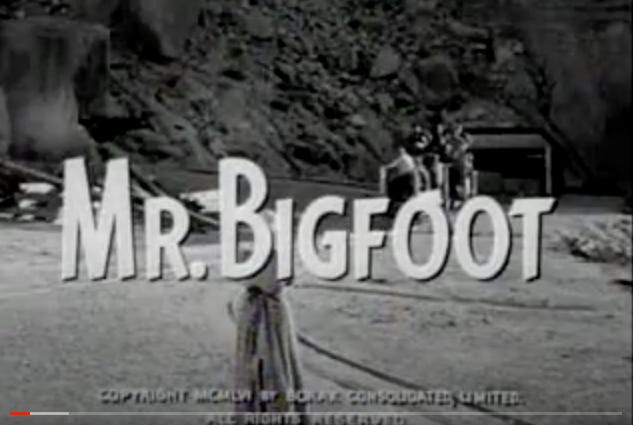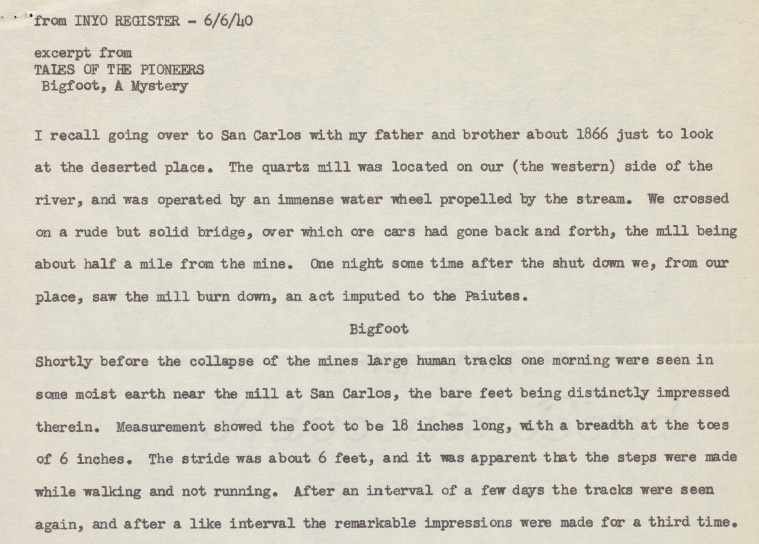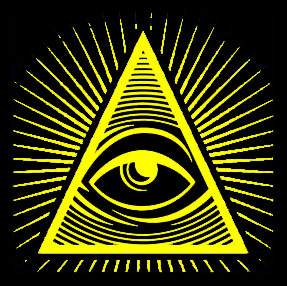It is usually said that the Humboldt Times coined the name “Bigfoot” in 1958, running a photo of Jerry Crew’s now-famous plaster casts under a banner headline, “Huge Foot Prints Hold Mystery of Friendly Bluff Creek Giant.”
But the Bigfoot name had been in the parlance of popular culture for more than a decade by the time Andrew Genzoli’s piece was published. In 1956, two years prior, “Death Valley Days” aired an episode entitled “Mr. Bigfoot,” in which giant footprints appear outside a California mining camp.
Further, the episode was a TV upgrade of a 1942 “Death Valley Days” radio show, titled simply “Bigfoot.” Both versions of the story featured Western settlers in an uproar about mysterious giant footprints, which turn out to be part of a secret matchmaking plan to pair a short, nerdy cowpoke with the girl of his dreams.
Both episodes reveal the climactic Bigfoot hoax only to the audience, while the settlers remain puzzled. Both episodes were written by Ruth C. Woodman.
Death Valley confidential
Ruth Cornwall Woodman was a British secretary-turned-writer, born in 1894 and educated at Vassar College in New York. According to a bio prepared by the University of Oregon’s Special Collections & University Archives, the Pacific Coast Borax Co. hired Woodman to write “Death Valley Days” episodes in 1930. The company stipulated that stories should reflect first-hand knowledge of the Death Valley region, located in Inyo County, Calif.
For 14 years, Woodman’s annual expeditions to Death Valley involved interviewing old-timers and rifling through local newspaper archives. One summer, she came across an item in the June 6, 1940 edition of the Inyo Register entitled “Tales of the Pioneers: Bigfoot, A Mystery.”
The columnist had interviewed an old-timer about the mining camps in the Owens Valley.
Ruth Woodman transcribed this 1940 column in the Inyo Register.
The article continued:
Indians were shown the footprints and asked if they knew who made them. They were wise and shrugged their shoulders and said, “Heap no see,” “Call him Bigfoot,” “Nobody see him” … with a wave of the hand toward the Inyo Range, they said, “He live there.”
A source named Tommy Kehoe told the columnist about similar prints in nearby Bend City. “Now and then the very large footprints appeared – so big, Tommy said, that it was unbelievable that a man made it. The whites called the maker ‘Bigfoot.’ ”
The Inyo Register item inspired Woodman’s 1942 radio script, set in the historic Mormon settlement of St. Thomas in southeastern Nevada. Stubby Weeks is a 27-year-old carpenter measuring all of 5-feet-2, infatuated with Merinda of the nearby Pratt Ranch. Stubby’s attempts to date “Merry,” as she is called, are thwarted by her interest in local hunks who swagger their manliness by winning various races and games at the annual church picnic.
Off and moping, Stubby befriends a traveling professor in search of fossils, bones and archeological artifacts. The nearby Gypsum Cave has been particularly promising, complete with bones from a prehistoric giant ground sloth.
Several weeks later, settlers come across human-like tracks measuring nearly a yard long – leading out of town towards Gypsum Cave. The only man fearless enough to go tracking the giant is Stubby Weeks, whose courage melts the heart of young Merry. On the morning of their wedding day, Stubby’s incredibly discreet friend stops by the carpentry shop to let it be known he witnessed Stubby making the mysterious tracks with wooden feet. The hoax will remain their little secret!
Woodman’s notes don’t indicate where she got inspiration for the hoax-plot. The news item indicates the origin of the massive footprints was never resolved.
Mr. Bigfoot goes Hollywood
Fast forward 14 years – in the 1956 television version, Stubby is the clerk at the Anniversary Mine near Death Valley in 1905. Merry returns as the camp belle more interested in Dutch Hogan’s biceps than Stubby’s rock collection. Assuming failure in manly competition at the company picnic, Stubby wanders off to cross paths with an anthropologist on expedition. Professor Muchmore has just discovered a seven-foot-long mastadon tusk in the nearby desert.
During a second conversation with the professor, Stubby learns that footprints measuring 18 inches long and 6 inches wide were found in the Owens Valley some 50 years prior. “Watch was kept but Bigfoot, as the Indians called him, never showed himself,” Muchmore says, producing a diagram of the footprint. “To this day, he’s a mystery.”
Once again, giant footprints mysteriously appear around the camp to panic the miners and womenfolk. Stubby alone has the courage to stake out the water tank at night, hoping to confirm the existence of the giant – winning the heart of Merry.
In the final scene of the TV version, however, the professor confesses to the young couple that he made the prints with paper maché feet. “I was conducting a scientific experiment,” he says, “to prove that a man’s courage is often in inverse ratio to his size.”
“Mr. Bigfoot” aired on “Death Valley Days” on March 12, 1956
Two years before Jerry Crew showed his plaster cast footprints to the Humboldt Times, a Bigfoot hoax had been central to the plot of a popular TV series. No wonder Genzoli wrote his first Times columns with tongue in cheek. And, thus, the journalistic paper trail on Bigfoot goes back to 1940.
#bigfootstudies
Steven Saint Thomas holds monthly classes featuring journalistic inquiries into controversial subjects. Click here for details.






